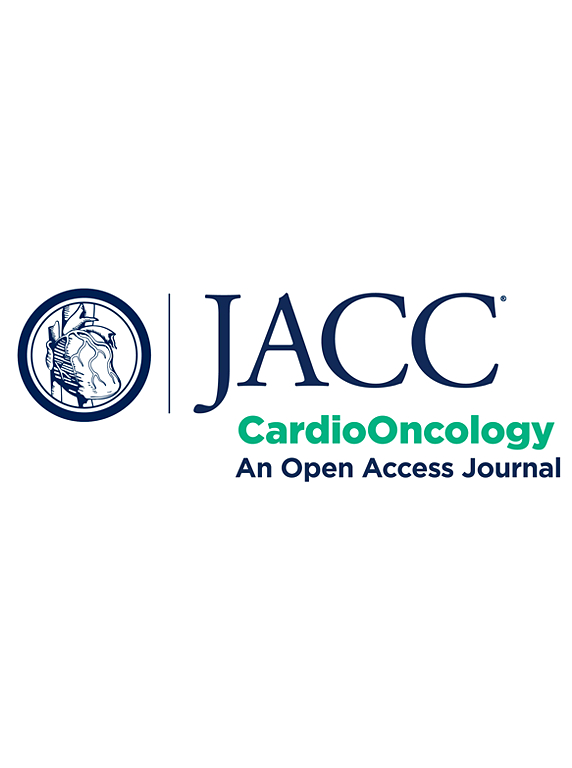Immune Checkpoint Inhibitor Myocarditis and Left Ventricular Systolic Dysfunction
IF 12.8
1区 医学
Q1 CARDIAC & CARDIOVASCULAR SYSTEMS
引用次数: 0
Abstract
Background
Immune checkpoint inhibitors (ICIs) have transformed cancer treatment, but ICI myocarditis (ICI-M) remains a potentially fatal complication. The clinical implications and predictors of left ventricular ejection fraction (LVEF) <50% in ICI-M are not well understood.
Objectives
The aim of this study was to identify factors associated with LVEF <50% vs ≥50% at the time of hospitalization for ICI-M. A secondary objective was to evaluate the relationship between LVEF and 30-day all-cause mortality.
Methods
The International ICI-Myocarditis Registry, a retrospective, international, multicenter database, included 757 patients hospitalized with ICI-M. Patients were stratified by LVEF as reduced LVEF (<50%) or preserved LVEF (≥50%) on admission. Cox proportional hazards models were used to assess the associations between LVEF and clinical events, and multivariable logistic regression was conducted to examine factors linked to LVEF.
Results
Of 757 patients, 707 had documented LVEFs on admission: 244 (35%) with LVEF <50% and 463 (65%) with LVEF ≥50%. Compared with patients with LVEF ≥50%, those with LVEF <50% were younger (<70 years), had a body mass index of <25 kg/m2, and were more likely to have received chest radiation (24.2% vs 13.5%; P < 0.001). Multivariable analysis identified predictors of LVEF <50%, including exposure to v-raf murine sarcoma viral oncogene homolog B1/mitogen-activated protein kinase inhibitors, pre-existing heart failure, dyspnea at presentation, and at least 40 days from ICI initiation to ICI-M onset. Conversely, myositis symptoms were associated with LVEF ≥50%. LVEF <50% was marginally associated with 30-day all-cause mortality (unadjusted log-rank P = 0.062; adjusted for age, cancer types, and ICI therapy, HR: 1.50; 95% CI: 1.02-2.20).
Conclusions
Dyspnea, time from ICI initiation, a history of heart failure, and prior cardiotoxic therapy may be predictors of an initial LVEF <50% in patients with ICI-M.
免疫检查点抑制剂心肌炎与左心室收缩功能障碍
免疫检查点抑制剂(ICI)已经改变了癌症治疗,但ICI心肌炎(ICI- m)仍然是一个潜在的致命并发症。ICI-M患者左室射血分数(LVEF) <;50%的临床意义和预测因素尚不清楚。目的本研究的目的是确定ICI-M住院时LVEF和≥50%的相关因素。次要目的是评估LVEF与30天全因死亡率之间的关系。方法国际ici -心肌炎登记处是一个回顾性的、国际的、多中心的数据库,包括757例ICI-M住院患者。患者在入院时按LVEF分为LVEF减少(50%)或LVEF保持(≥50%)。采用Cox比例风险模型评估LVEF与临床事件之间的关系,并采用多变量logistic回归分析与LVEF相关的因素。结果757例患者中,707例在入院时记录有LVEF: 244例(35%)LVEF≥50%,463例(65%)LVEF≥50%。与LVEF≥50%的患者相比,LVEF≥50%的患者更年轻(≥70岁),体重指数为25 kg/m2,接受胸部放疗的可能性更大(24.2% vs 13.5%;P & lt;0.001)。多变量分析确定了LVEF的50%预测因子,包括暴露于v-raf小鼠肉瘤病毒癌基因同源物B1/丝裂原活化蛋白激酶抑制剂,既往心力衰竭,出现时呼吸困难,以及从ICI开始到ICI- m发作至少40天。相反,肌炎症状与LVEF≥50%相关。LVEF <;50%与30天全因死亡率轻微相关(未校正log-rank P = 0.062;经年龄、癌症类型和ICI治疗调整后,HR: 1.50;95% ci: 1.02-2.20)。结论:呼吸困难、ICI开始时间、心力衰竭史和既往心脏毒性治疗可能是ICI- m患者初始LVEF(50%)的预测因子。
本文章由计算机程序翻译,如有差异,请以英文原文为准。
求助全文
约1分钟内获得全文
求助全文
来源期刊

Jacc: Cardiooncology
Multiple-
CiteScore
12.50
自引率
6.30%
发文量
106
期刊介绍:
JACC: CardioOncology is a specialized journal that belongs to the esteemed Journal of the American College of Cardiology (JACC) family. Its purpose is to enhance cardiovascular care for cancer patients by publishing high-quality, innovative scientific research and sharing evidence-based knowledge.
The journal aims to revolutionize the field of cardio-oncology and actively involve and educate professionals in both cardiovascular and oncology fields. It covers a wide range of topics including pre-clinical, translational, and clinical research, as well as best practices in cardio-oncology. Key areas of focus include understanding disease mechanisms, utilizing in vitro and in vivo models, exploring novel and traditional therapeutics (across Phase I-IV trials), studying epidemiology, employing precision medicine, and investigating primary and secondary prevention.
Amyloidosis, cardiovascular risk factors, heart failure, and vascular disease are some examples of the disease states that are of particular interest to the journal. However, it welcomes research on other relevant conditions as well.
 求助内容:
求助内容: 应助结果提醒方式:
应助结果提醒方式:


